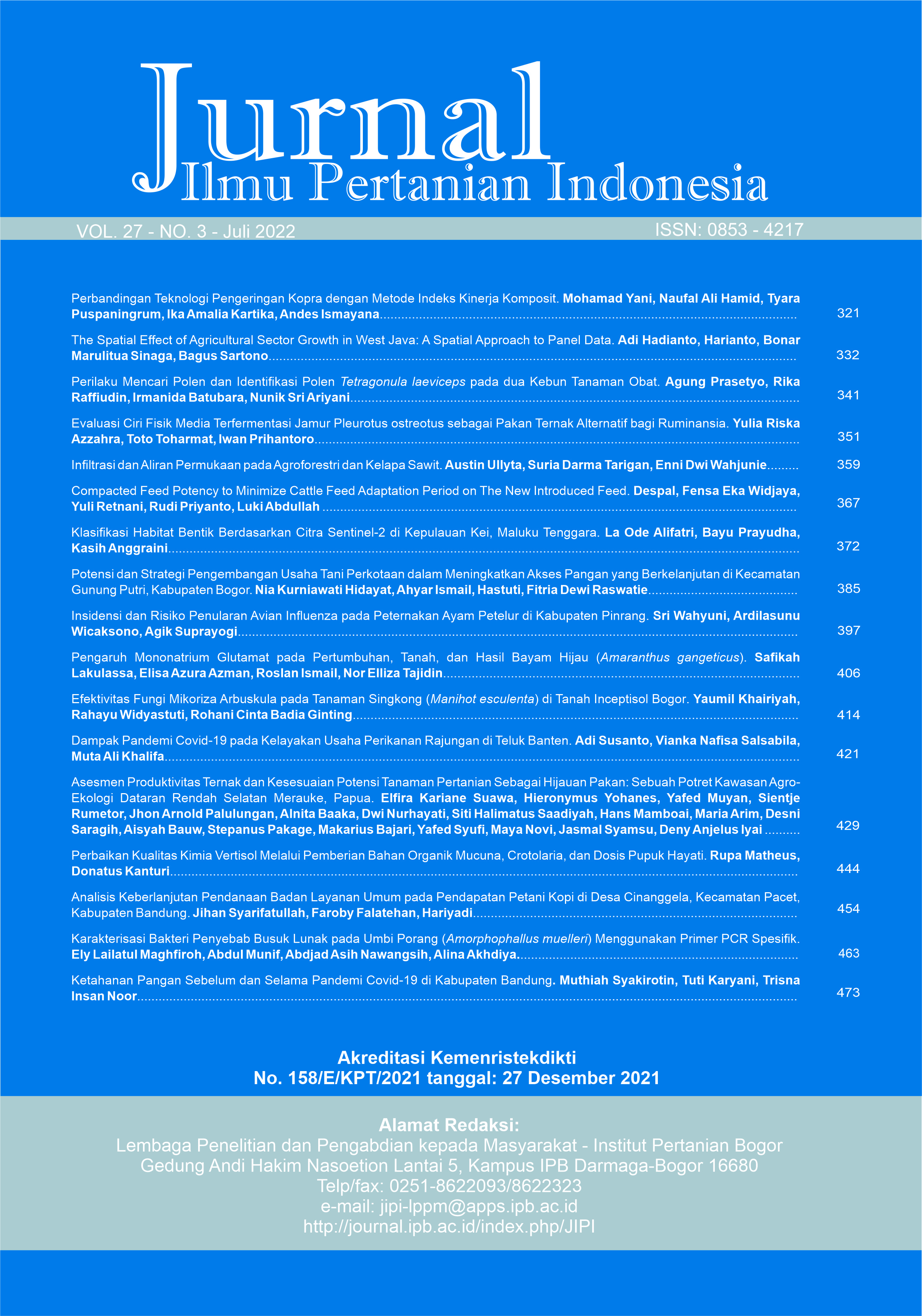Perilaku Mencari Polen dan Identifikasi Polen Tetragonula laeviceps pada dua Kebun Tanaman Obat
Abstract
Unit Konservasi Budidaya Biofarmaka (UKBB) and Kampoeng Djamoe Organik Martha Tilaar (KaDO) are two medicinal plantation that possibly as resources for stingless bees nectar and pollen. This study was aimed to describe the foraging behavior of Tetragonula laeviceps in medicinal plantations, determine the plant species which become the pollen resources, and the distance between the colony and medicinal plants. Observation on foraging behavior were divided into three activities, i.e. flying out from the nest, returning the nest with pollen, and returning the nest without pollen. We found a similar pattern of numbers of bees returning to the nest with pollen in both UKBB and KaDO that occurred in the morning with the highest between 9 and 10 am and gradually decreased in the afternoon. The bees in UKBB showed highly number flying out from the nest in around 3 pm which might be the activites of resin collection. We identified 11 and 16 pollen types at the UKBB and the KaDO, respectively. The pollen in both locations are from the families Amaryllidaceae, Anacardiaceae, Clusiaceae, Cucurbitaceae, Ebenaceae, and Sapindaceae. Our results revealed that the distance range of medicinal plants from the bees hives was 13.4-113,3 m. Thus, this data indicate that the hives should be located in the distance of the bee forage. The medicinal pollen identified in the T. laeviceps pollen pot confirmed the role of the bees as the ecosystem service in the medicinal plantations.
Keywords: foraging range, medicinal plants, pollination, pollen, Tetragonula
Downloads
References
Asadi N, Bahmani M, Shahsavari S, Asadi-Samani, M. 2017. Identification and introduction of the medicinal plants used by honeybees in Markazi Province. International Journal of Pharmaceutical and Phytopharmacological Research. 7: 15–18.
Behera LK, Mehta AA, Dholariyah CA, Sinha SK, Gunaga RP, Patel SM. 2017. Bee foraging on MPTS by honeybee species during minor honey flow period in South Gujarat Condition. International Journal Usuf Mngt. 18(2): 47–53.
[BPS Jabar] Badan Pusat Statistik Jawa Barat. 2016. Rata-Rata Suhu Udara, Kelembaban, Tekanan Udara, Kecepatan Angin, Curah Hujan, dan Penyinaran Matahari Menurut Stasiun di Provinsi Jawa Barat, 2016. Badan Meteorologi Klimatologi dan Geofisika. Bandung (ID).
Cockerell TDA. 1922. Australian bees in the Queensland museum. Memoirs of the Queensland Museum. 7: 257–279.
Camargo, JMF. 1988. Meliponinae (Hymenoptera, Apidae) da coleção do "Instituto di entomologia agraria", Portici, Itália. Revista Brasileira de Entomologia (Brazilian Society of Entomology). 32: 351–374.
Cockerell, TDA. 1922. Australian bees in the Queensland museum. Memoirs of the Queensland Museum. 7: 257–279.
Dethier VG, Eliot S. 1964. Animal Behavior: It Evolutionary and Neurological basis, second edition. New Jersey [USA]: Prentice-Hall Inc.
Erdtman G. 1972. Pollen Morphology and plant Taxonomy. New York (US): Hafner Publishing.
Ferreira Jr, NT, Blochtein, Morae JF de. 2010.Seasonal flight and resource collection patterns of colonies of the stingless bee Melipona bicolor schencki Gribodo (Apidae, Meliponini) in an Araucaria forest area in southern Brazil. Revista Brasileira de Entomologia (Brazilian Society of Entomology. 54(4): 630–636. https://doi.org/10.1590/S0085-562620100 00400015
Friese H. 1909. Die Bienen fauna von Neu–Guinea. Annales Historico–Naturales Musei Nationalis Hungarici (Természettudományi Múzeum évkönyve). 7: 179–288.
Heard TA. 1999. The role of stingless bees in crop pollination. Ann. Rev. Entomol. 44: 183–206. https://doi.org/10.1146/annurev.ento.44.1.183.
Hilario S.D, Imperatriz F.V.I, Kleinert A. de M. P. 2000. Flight Activity and Colony Strength in the Stingless Bee Melipona bicolor bicolor (Apidae, Meliponinae). Rev. Brasil. Biol. 60(2): 299-306. https://doi.org/10.1590/S0034-71082000000200014
Huang TC. 1972. Pollen Flora of Taiwan. Taiwan (TW): Nasional Taiwan University.
Inoue T, Salmah S, Abbas I, Yusuf E. 1985. Foraging behavior of individual workers and foraging dynamics of colonies of three sumatran stingless bees. Researches on Population Ecology (Kyoto). 27: 373–392. https://doi.org/10.1007/ BF02515474
[KaDO] Kampoeng Djamoe Organik Martha Tilaar. 2014. Tentang Kami. Bekasi: Kampoeng Djamoe Organik Martha Tilaar. http://www.kampoeng djamoemarthatilaar.com/subpage.php?page=tentang_kami&id=4. [Internet]. Diakses 2020 Juli 17.
Kozuharova E., 2019. Pollination ecology of medicinal plants – what we must not neglect for their sustainable use. Genetics and Plant Physiology. 9(1–2): 22–35.
Leonhardt SD. 2010. Resin collection and use in stingless bees. (Disertasi). Julius-Maximilians-Universität Würzburg. Würzburg.
Martin P, Batteson P. 1993. Measuring Behaviour An Introductory Guide. Second Edition. Cambridge [USA]: Cambridge University Press. https://doi.org/ 10.1017/CBO9781139168342
Michener CD. 1974. The Social Behavior of the Bees. Cambridge (USA): Harvard Univ Press.
Michener CD. 2013. Pot-Honey: A Legacy of Stingless bees. Vit P, Pedro SRM, Roubik DW. Editor. New York (US): Springer Press. 3–17.
Paiva, E. A. S. 2011. Petaline nectaries in Swietenia macrophylla (Meliaceae): Distribution and structural aspects. Flora - Morphology, Distribution, Functional Ecology of Plants. 206(5): 484–490. https://doi.org/10.1016/j.flora.2010.09.009
Sakagami SF, Inoue T, Salmah S. 1990. Stingless bees of central Sumatra. In: Sakagami SF, Ohgushi R, Roubik DW. Natural History of Social Wasps and Bees in Equatorial Sumatra. Sapporo (JP): Hokkaido Univ Pr.
Smith F. 1859. Catalogue of Hymenopterous insects collected by Mr. A. R. Wallace at the Islands of Aru and Key. Journal of the Proceedings of the Linnean Society, Zoology. 3:132–178. https://doi.org/ 10.1111/j.1096-3642.1859.tb00077.x
Smith JP, Heard TA, Beekman M, Gloag R. 2016. Flight range of the Australian stingless bee Tetragonula carbonaria (Hymenoptera: Apidae). Austral Entomology. 56: 50–53. https://doi.org/ 10.1111/aen.12206
[TropBRC] Tropical Biopharmaca Research Center 2016. Unit Konservasi Budidaya Biofarmaka. Bogor: http://biofarmaka.ipb.ac.id/biofarmaka/ 2016/FlyerUKBB 2016.pdf. [Internet]. Diunduh 2020 Juli 17.
This journal is published under the terms of the Creative Commons Attribution-NonCommercial 4.0 International License. Authors who publish with this journal agree to the following terms: Authors retain copyright and grant the journal right of first publication with the work simultaneously licensed under a Creative Commons Attribution-NonCommercial 4.0 International License. Attribution — You must give appropriate credit, provide a link to the license, and indicate if changes were made. You may do so in any reasonable manner, but not in any way that suggests the licensor endorses you or your use. NonCommercial — You may not use the material for commercial purposes.






















